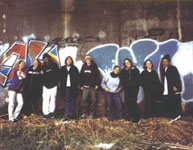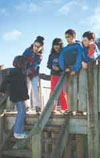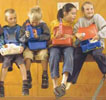
The Project directors acknowledge the vital support and contributions
of many people to this report, including:
•
the very dedicated staff of the Educational Assessment Research
Unit
• Heleen Visser and other staff members of the Ministry of
Education
• members of the Project’s National Advisory Committee
• members of the Project’s Health and Physical Education Advisory Panel
• principals and children of the schools where tasks were
trialled
• principals, staff and Board of Trustee members of the 255
schools included in the 2006 sample
• the 2878 children who participated in the assessments and
their parents
• the 96 teachers who administered the assessments to the
children
• the 46 senior tertiary students who assisted with the marking
process
• the 205 teachers who assisted with the marking of tasks
early in 2007.

New
Zealand’s National Education Monitoring Project (NEMP) commenced
in 1993, with the task of assessing and reporting on the achievement
of New Zealand primary school children in all areas of the school
curriculum. Children are assessed at two class levels: year 4 (halfway
through primary education) and year 8 (at the end of primary education).
Different curriculum areas and skills are assessed each year, over
a four-year cycle. The main goal of national monitoring is to provide
detailed information about what children can do so that patterns
of performance can be recognised, successes celebrated, and desirable
changes to educational practices and resources identified and implemented.
Each year, small random samples of children are selected nationally,
then assessed in their own schools by teachers specially seconded
and trained for this work. Task instructions are given orally by
teachers, through video presentations, or in writing. Many of the
assessment tasks involve the children in the use of equipment and
supplies. Their responses are presented orally, by demonstration,
in writing, or through submission of other physical products. Many
of the responses are recorded on videotape for subsequent analysis.
In 2006, the fourth year of the third cycle of national monitoring,
two areas were assessed: health and physical education, and the
writing, listening and viewing components of the English curriculum.
This report presents details and results of the assessments of students’ skills, knowledge, perceptions and attitudes relating to health and physical education.
| ASSESSING
HEALTH & PHYSICAL EDUCATION |
Chapter 2 presents the NEMP framework for health and physical education. It has as its central organising theme personal and community well-being through enhancing health practices and physical education. Three areas of knowledge and understandings are identified, together with three clusters of skills, and students’ attitudes and involvement. |
|
| PERSONAL HEALTH AND PHYSICAL DEVELOPMENT |
Chapter 3 presents the results that students achieved on 22 tasks relating to personal health and physical development. Averaged across 170 task components administered to both year 4 and year 8 students, nine percent more year 8 than year 4 students succeeded with these components. Year 8 students performed better on 78 percent of the components. Trend analyses showed no meaningful change since 2002 for year 4 or year 8 students. Averaged across 42 task components attempted by year 4 students in both years, two percent more students succeeded in 2006 than in 2002. At year 8 level, with 79 task components included in the analysis, one percent more students on average succeeded with the task components in 2006 than in 2002.

|
Students’ responses suggested quite strong awareness of some health and safety issues and messages. What was also evident, however, was that this awareness was often rather one-dimensional: having identified one or two key points, students had little to say about other important points. For instance, they emphasised physical heath and largely ignored social, emotional and spiritual health. Similarly, a major focus as a cause of infection was sharing drink bottles, with less focus on transfer through other body contact. |
| |
| MOVEMENT CONCEPTS AND MOTOR SKILLS |
Chapter 4 reports the results achieved on 25 tasks involving movement concepts and motor skills. The activities often involved the use of equipment, such as balls, bats and skipping ropes, in addition to physical coordination. Averaged across 124 task components administered to both year 4 and year 8 students, 14 percent more year 8 than year 4 students succeeded with these components. Year 8 students performed better on 90 percent of the components. The smallest differences generally occurred on task components that focused on technique, with the largest differences on task components that emphasised speed and precision.
| Trend analyses showed no meaningful change since 2002 for year 4 or year 8 students. Averaged across 39 task components attempted by year 4 students in both years, two percent more students succeeded in 2006 than in 2002. At year 8 level, with 47 task components included in the analysis, two percent more students on average succeeded with the task components in 2006 than in 2002. |
|
| RELATIONSHIPS WITH OTHER PEOPLE |
Chapter 5 presents the results for 11 tasks about relationships with other people. Students were asked to show what they understood about how the attitudes, values, actions and needs of people interact, and to suggest strategies for dealing with relationship problems. Many of the tasks were marked both descriptively and evaluatively. Descriptive components explored students’ ideas about issues and their possible solutions, while the evaluative components were ratings of the overall merit of the students’ responses.
 |
Averaged across 66 task components administered to both year 4 and year 8 students, seven percent more year 8 than year 4 students succeeded with these components. Year 8 students performed better on 80 percent of the components. Trend analyses showed no meaningful
change since 2002 for year 4 students, but a modest improvement for year 8 students. Averaged across 14 task components attempted by year 4 students in both years, two percent more students succeeded in 2006 than in 2002. At year 8 level, with 21 task components included in the analysis, five percent more students on average succeeded with the task components in 2006 than in 2002. |
| HEALTHY COMMUNITIES AND ENVIRONMENTS |
Chapter 6 presents the results for
six tasks relating to healthy communities and environments. The stated aim of this strand of the curriculum is for students to participate in creating healthy communities and environments by taking responsible
and critical action. This is not an easy area in which to create assessment tasks that can stand by themselves, separate from class programmes and activities and children’s life experiences.
| Averaged across 66 task components administered to both year 4 and year 8 students, seven percent more year 8 than year 4 students succeeded with these components. Year 8 students performed better on 77 percent of the components. Trend analyses showed no meaningful change since 2002 for either year 4 or year 8 students. Averaged across 22 task components attempted by year 4 students in both years, one percent more students succeeded in 2006 than in 2002. At year 8 level, with the same 22 task components included in the analysis, one percent more students on average succeeded with the task components in 2006 than in 2002. |
|
|
| HEALTH & PHYSICAL EDUCATION
SURVEYS |
|
| Chapter 7 reports the results of surveys of students’ attitudes about and involvement in health and physical education activities. Physical education was the favourite of 14 curriculum areas for year 8 students, and the second most popular (after art) for year 4 students. Health was last in popularity at both year levels, yet less than 20 percent of students at both levels expressed negative attitudes towards studying it, and students also continue to be very positive about
the usefulness of learning about
health. Only 39 percent of year 4 students and 33 percent of year 8 students believed their class did things that helped them learn about health “lots” or “quite a lot”. These figures were essentially unchanged between 1998 and 2006.
When asked to write down three really important things they had learned in physical education, the overwhelming response of students at both year levels related to the rules, techniques or skills of particular sports or activities. The need for good sportsmanship came next, mentioned by about one third of the students at both year levels. Year 8 students placed similar emphasis on the need for positive attitudes and effort and on cooperation with others. Ideas mentioned less frequently included the importance of fitness, warm-ups or stretches, having fun, and training or practising. These patterns changed very little from 2002 to 2006.
The percentage of students who indicated that they didn’t know how good their teacher thought they were at physical education has decreased by about 10 percent at both year levels since the 2002 survey, and at year 8 level has decreased by 17 percent from the 1998 survey. That was very different from the picture in the health education survey, where quite high percentages of year 4 students and very high percentages of year 8 students said they did not know how good their teacher or family thought they were in health education.
Year 8 students reported a little more vigorous physical activity than year 4 students in the 24 hours preceding the survey. Reported activity levels have not changed substantially between 1998 and 2006.
|
|
Chapter 8 reports the results of
analyses that compared the performances of different demographic subgroups. School type (full primary, intermediate, or year 7 to 13 high school), school size, community size and geographic zone were not
important factors predicting achievement on the health or PE tasks at either year level. The same was true for the 2002 and 1998 assessments.
There were statistically significant differences in the performance of students from low, medium and high decile schools on 41 percent of the health tasks at year 4 level (compared to 32 percent in 2002 and 44 percent in 1998), and 44 percent of the health tasks at year 8 level (compared to 44 percent in 2002 and 38 percent in 1998). For the PE tasks, there were differences on 26 percent of the tasks at year 4 level (compared to five
percent in 2002 and 17 percent in 1998), and 33 percent of the tasks at year 8 level (compared to eight percent in 2002 and 17 percent in 1998).
For the comparisons of boys with girls, Pakeha with Mäori, Pakeha with Pasifika students, and students for whom the predominant language at home was English with those for whom it was not, effect sizes were used. Effect size is the difference in mean (average) performance of the two groups, divided by the pooled standard deviation of the scores on the particular task. For this summary, these effect sizes were averaged across all tasks.
Year 4 girls averaged slightly higher than boys on health tasks, with a mean effect size of 0.09 (exactly the same as in 2002). Year 8 girls averaged moderately higher than boys on health tasks, with a mean effect size of 0.20 (little different from 0.17 in 2002). On the PE tasks, year 4 boys averaged a little higher than girls, with a mean effect size of 0.10 (slightly reduced from 0.15 in 2002). Year 8 boys also averaged slightly higher than girls on PE tasks, with a mean effect size of 0.10 (exactly the same as in 2002). Boys did better on tasks that involved physical strength or kicking, hitting, catching or throwing balls, while girls did better on some of the other tasks.
Pakeha students averaged moderately higher than Mäori students on the health tasks, with mean effect sizes of 0.25 for year 4 students (slightly increased from 0.20 in 2002) and 0.23 for year 8 students (exactly the same as in 2002). On the PE tasks, however, Mäori students scored slightly higher than Pakeha students at both year levels. The mean effect size for year 4 students was 0.09 (slightly reduced from 0.14 in 2002), while for year 8 students the mean effect size was 0.06 (also slightly reduced from 0.10 in 2002).
Pakeha students averaged moderately higher than Pasifika students on the health tasks, with mean effect sizes of 0.26 for year 4 students and 0.32 for year 8 students (revealing substantially reduced disparities of performance compared to 2002, when the two effect sizes were 0.40 and 0.45). On the PE tasks, Pasifika students averaged a little higher than Pakeha students at year 4 level (mean effect size of 0.09, reduced from 0.17 in 2002), but the converse was true at year 8 level (mean effect size of 0.10 favouring Pakeha students, increased from 0.00 in 2002).
Compared to students for whom the predominant language at home was not English, students from homes where English predominated averaged slightly higher at year 4 level (mean effect size 0.08 for both health and physical education tasks) and on year 8 level physical education tasks (mean effect size of 0.03) Their advantage was greater on year 8 health tasks (mean effect size of 0.20). Comparative figures are not available for the assessents in 2002.
|
|




